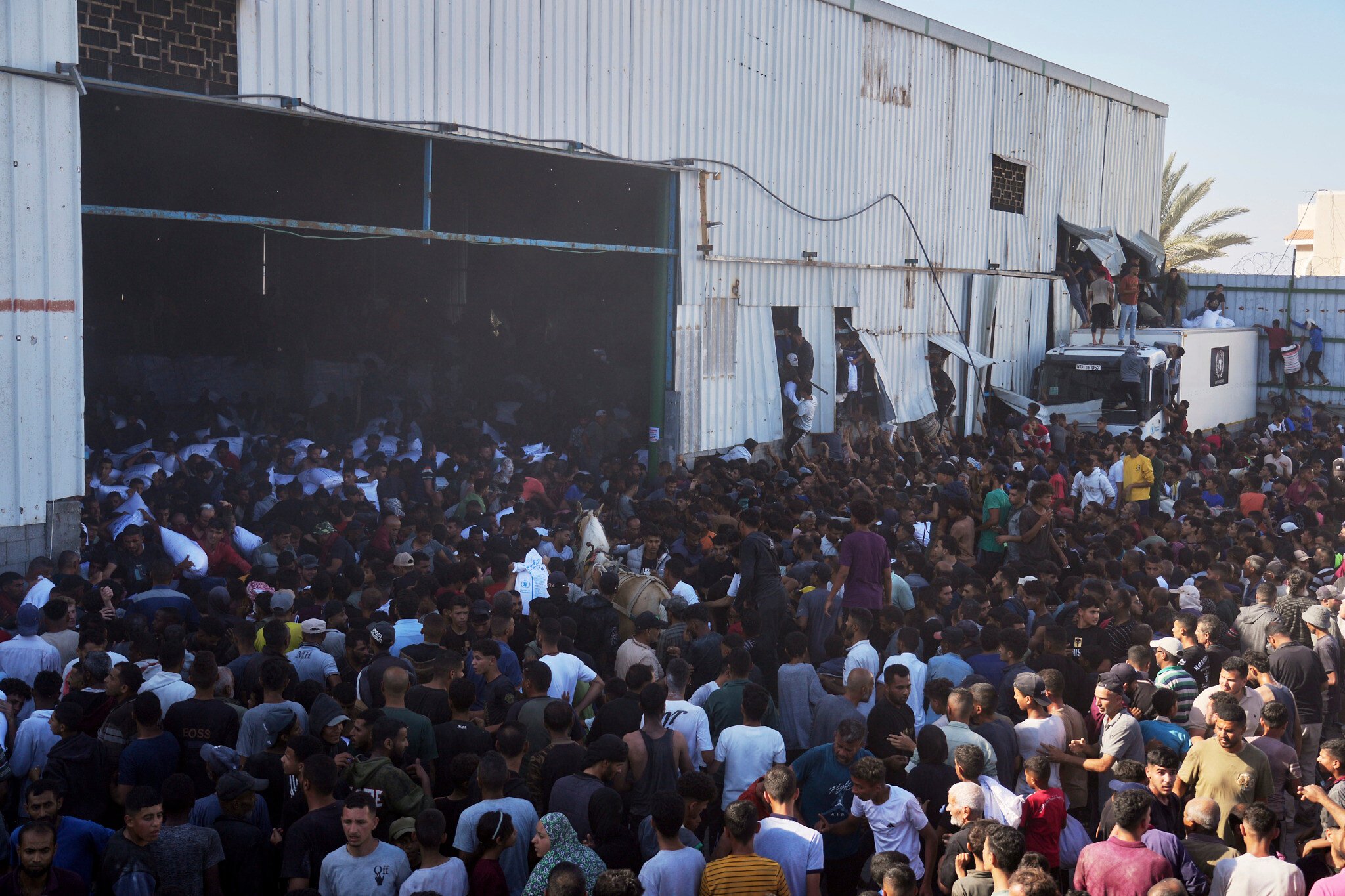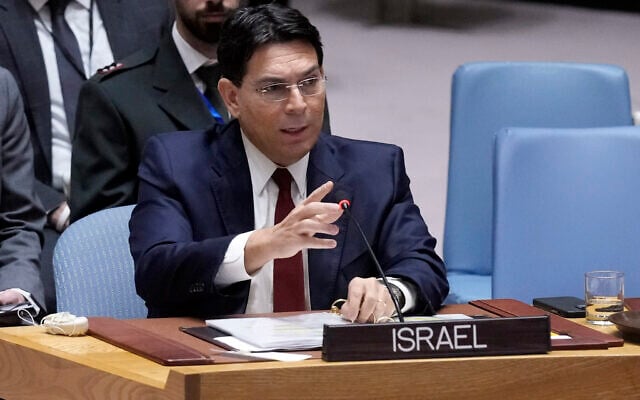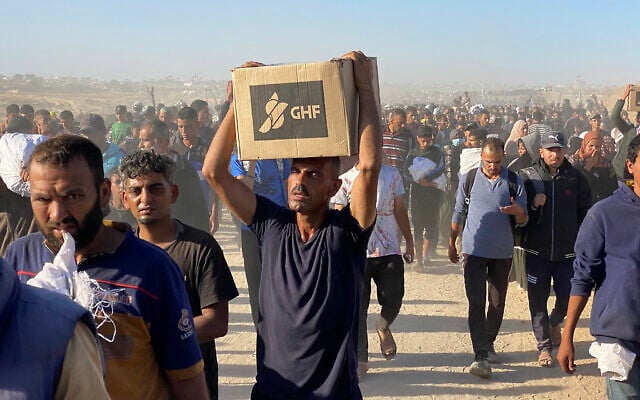



Hundreds of Palestinians stormed a United Nations food warehouse in central Gaza on Wednesday, shouting and shoving each other and ripping off pieces of the building to get inside, the UN said. Palestinian hospital officials said four people died in the chaos, two of them shot.
Israel accused the Hamas terror group of opening fire. There were no Israeli troops in or near the area of the UN’s World Food Program warehouse at the time, and the IDF is not operating in Deir al-Balah.
“Hordes of hungry people broke into WFP’s Al-Ghafari warehouse in Deir Al-Balah, Central Gaza, in search of food supplies that were pre-positioned for distribution,” the UN’s World Food Program said in a statement on X.
“Initial reports indicate two people died and several were injured in the tragic incident,” the WFP said, adding that it was still confirming details.
The WFP said “humanitarian needs have spiraled out of control” after Israel’s long blockade of supplies entering Gaza, which began in early March to pressure the Palestinian terror group Hamas into releasing hostages and agreeing to a truce.
Officials at the Al-Aqsa Martyrs Hospital said two people were fatally crushed in the crowd and two others died of gunshot wounds.
Eyewitness video independently verified by Reuters showed large crowds of people pushing into the warehouse and removing bags and boxes, as gunfire can be heard.
Hamas, in a statement, denied that it had opened fire or that it operated the warehouse.
The Israeli Foreign Ministry posted a video of the scene inside the warehouse during the looting, and accused Hamas of opening fire to protect stores that it was keeping from Gazans.
The incident comes as the independent Israeli and US-backed Gaza Humanitarian Foundation began operating an aid mechanism that would largely bypass the UN and keep supplies away from Hamas.
The previous day, Gaza’s Hamas-run health ministry said that at least one Palestinian had been killed and 48 others wounded when a crowd was fired upon while overrunning a new GHF aid-distribution site.
The Israeli military, which guards the site from a distance, said it fired only warning shots to control the looting. The foundation said its military contractors guarding the site did not open fire.
The GHF claimed Wednesday that the casualty figures claimed by Hamas about the Tuesday looting were false and spread by the terror group to hamper the new aid operation.

GHF said only two people have been injured at its compounds since it began operating in Gaza on Monday. “To-date two Gazans have required medical care that was delivered on-site — one relating to dehydration and another who was injured by others seeking aid,” said a GHF statement.
Among the false reports the GHF said Hamas was spreading was that the aid organization halted operations due to gunfire at one of its sites earlier Wednesday.
The GHF further said it had successfully opened its second aid distribution center on Wednesday in southern Gaza.
At a meeting of the United Nations Security Council, Israel’s Ambassador Danny Danon accused the UN of deliberately undermining the new US and Israel-backed aid mechanism in the Gaza Strip through corrupt means.
Claiming that he has acquired new “shocking information,” Danon told the council that the UN “is using threats, intimidation and retaliation against NGOs that choose to participate in the new humanitarian mechanism.”
He asserted that a number of “major international NGOs” had been punished by the UN after indicating that they would take part in the new aid initiative and would “ignore the UN’s calls for a boycott.”
“The UN’s response was brutal. It was Mafia-like,” the envoy said. “Without any discussion, without a due process, the UN removed those NGOs from the shared aid database,” a central system for tracking aid deliveries into Gaza established through a UN General Assembly resolution.
Danon, in his speech, did not provide any evidence or the names of the NGOs he alleges were targeted.
Upon request for further information to back the envoy’s claims, Danon’s office told The Times of Israel that it is aware of a certain number of NGOs that the UN worked to prevent from cooperating with the aid plan, but that this information can only be provided by the UN directly.
The UN did not immediately respond to a request for comment.
Stephane Dujarric, spokesman for UN Secretary-General Antonio Guterres, reiterated the world body’s opposition to coordinating with GHF.
“We will not participate in operations that do not meet our humanitarian principles,” Dujarric told AFP.
He said the UN was doing all it could to send aid, adding that since last week, 800 truckloads had been approved by Israel, but fewer than 500 made it into Gaza.
The new GHF aid initiative became operational this week, partially replacing the UN-led framework that had previously managed humanitarian assistance in Gaza, following Israel’s decision to lift a nearly three-month aid blockade on the strip.
Israel says it helped establish the new aid mechanism to prevent Hamas from siphoning off supplies, but UN agencies say they have mechanisms for this purpose while delivering aid to all parts of the territory. The GHF has drawn heavy criticism from the UN and various international actors, who argue it falls short of addressing the dire humanitarian crisis in the enclave.
The GHF says it has established four hubs, two of which have begun operating in the now mostly uninhabited Rafah. It said around eight truckloads of aid were distributed at the hubs on Wednesday without incident.
About 600 trucks entered Gaza every day during the ceasefire earlier this year.
At the meeting, a United Nations envoy compared the limited aid being allowed into Gaza to “a lifeboat after the ship has sunk.”
Sigrid Kaag, acting UN special coordinator for the Mideast, told the UN Security Council that people facing famine in Gaza “have lost hope.”
“Instead of saying ‘goodbye,’ Palestinians in Gaza now say, ‘See you in heaven,'” Kaag said.
The Palestinian ambassador to the UN broke down as he alleged that 1,300 children have been killed and 4,000 wounded since the latest temporary ceasefire between Israel and Hamas collapsed in March, and spoke of mothers seen “embracing their motionless bodies, caressing their hair, talking to them, apologizing to them.”
“If this is civilized,” Riyad Mansour said, “what is barbarism?”
Gaza casualty figures, which come from Hamas-controlled authorities, cannot be verified and do not differentiate between combatants and civilians.
More than half the Security Council called for the 15-member body to act on Gaza. Slovenia’s UN Ambassador Samuel Zbogar said some members are working on a draft resolution to demand unimpeded aid access.
“Remaining silent is not an option,” he told the council.
The war in Gaza began when Hamas-led terrorists stormed into southern Israel in the October 7 attack, killing some 1,200 people, mostly civilians, and abducting 251 as hostages. Hamas still holds 58 hostages, around a third of them believed to be alive. Most of the rest were released in ceasefire deals or other agreements. Israeli forces have rescued eight and recovered dozens of bodies.
The Hamas-run Gaza health ministry says more than 53,000 people in the Strip have been killed or are presumed dead in the fighting so far, though the toll cannot be verified and does not differentiate between civilians and fighters. Israel says it has killed some 20,000 combatants in battle as of January and another 1,600 terrorists inside Israel on October 7.
Israel has said it seeks to minimize civilian fatalities and stresses that Hamas uses Gaza’s civilians as human shields, fighting from civilian areas, including homes, hospitals, schools, and mosques.
US efforts to mediate a ceasefire were said to be making progress, though gaps still remained between the sides.


